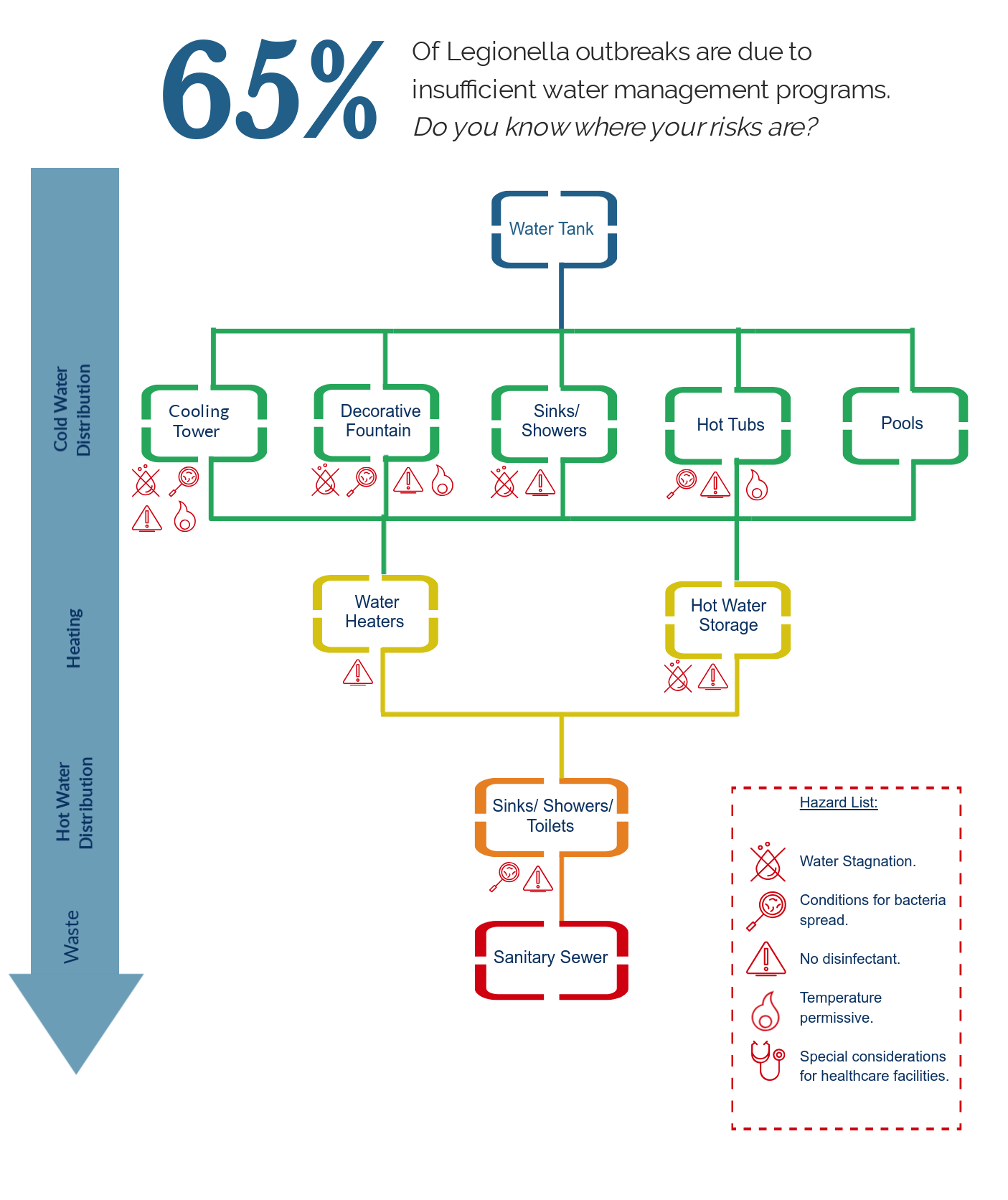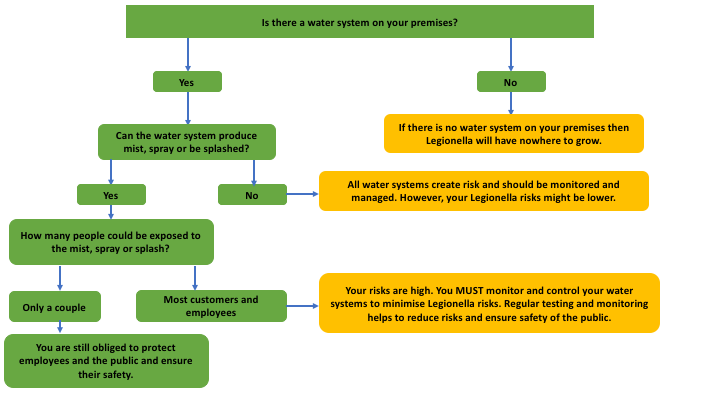Legionella Risks
Although Legionnaires' disease is on the rise [1] many businesses and individuals still ignore the risks associated with Legionella bacteria. Lack of awareness and understanding, is leading people to believe that:
- Legionella is not their problem at all or
- they have no legal requirement to manage and control Legionella risks.
Unfortunately, in both cases they could not be more wrong.
Where does Legionella grow?
According to the UK Health and Safety website, Legionella can grow and spread wherever water is stored or re-circulated and where water is kept at temperatures between 20-45°C. This is where the bacteria breeds the fastest but can arguably survive and spread outside of these conditions. Legionella also thrives in systems where there are sufficient nutritional sources for the bacteria to grow.
But what does this mean?
Have a closer look:

Every water system in the building creates a potential risk!
According to research conducted with Health and Safety professionals around the world, 58% of them agree that Legionella is a health risk that they have overlooked in their business. Additionally, 91% of them admit that if they have Legionella in their water systems they would want to know as quickly as possible so that they could take fast action.
Why Should You Care?
Firstly, Legionella is a global problem. In recent years reported cases of Legionaries’ disease have been growing at an alarming rate. In 1993, there were a total of 1,242 cases of Legionnaires’ disease in Europe. In 2018, this number had increased to a total of 5,960 cases [2]. And in the US, reports from 2017 show that cases of Legionnaires’ disease have gone up by 13.6% [3] that’s double the increase of the year previous.
The infection is now killing 1 in every 10 people who are infected. This number can increase in high risk industries. The CDC reports that 1 in 4 people who get the infection from a health care facility will die [4].
Not only that, but the ramifications of a Legionella outbreak can be catastrophic in terms of reputation, possible business closure, and cost including heavy fines should your Legionella management be in question.
If you fail to take the necessary measures to decrease the risk of Legionella to your staff and the public, both you and your organisation will be liable for prosecution.
It is also possible for managers and directors to be fined and even imprisoned under health and safety legislation, or under common law, if a death had occurred because of the individual’s negligence
These fines are not to be taken lightly and are substantial enough to shut down your business. For example:
- In 2012, a warehouse store with a dirty hot tub display caused an outbreak of Legionnaires Disease. They were fined £1 million for their negligence [5].
- In 2016, a multinational security services company was fined £1.8 million after failing to reduce the risk of Legionnaires’ disease from its water systems [6].
- In 2012, Basildon Hospital was ordered to pay £350,000 in fines and costs for failing to ensure the safety of its patients [7].
- In 2012 a firm in Somercotes, Derbyshire, was ordered to pay out almost £190,000 when the water treatment program for cooling towers was found to be severely ineffective [8].
Remember : You do not need to be identified as the source of an outbreak nor do people have to die for you to be prosecuted. You just have to be found negligent.
Legionella is not my problem.

Is Legionella testing a legal REQUIREMENT?
In many countries there is no prescriptive legal framework specifically for Legionella. Usually you would be asked to follow practical advice and guidance. Employers are obliged to provide protection to risk of exposure to Legionella Bacteria which may arise from work activities. In the UK, The Management of Health and Safety at Work Regulations provide the framework of how health and safety should be controlled in a work place. This includes risk assessment, competent provision of health and safety law, the provision of procedures to be followed by any employee should a situation presenting serious and imminent danger arise and co-operation and co-ordination where employees share a work space [9].
Will the lack of legislations stop the government from fining you, should you be found negligent and responsible for people getting infected or even worse, dead?
As you have seen in the previous examples, the answer is no.
Any breach of health and safety regulations is as a criminal offence and as such, any company or duty holder found to be in breach of these health and safety regulations could face prosecution. If found guilty, the company or person responsible could face a hefty fine or even imprisonment.
What can you do to reduce your Legionella risks?
Due to the existence of Legionella bacteria in ALL engineered water systems, it is important to design and operate water systems under conditions that identify and control the risks, thereby preventing Legionella from becoming dangerous.
The systems for controlling Legionella growth vary by country and region, but all have the same principles.
-
Temperature Control
In temperate countries, water temperature is used to control the risk from Legionella. Water systems should be operated at temperatures that prevent Legionella growth: hot-water tanks should be kept at temperatures of 60°C (140°F) or higher and hot water should be distributed at 50°C (122°F) or higher throughout the whole water system. This kills the bacteria. Cold water should be stored and distributed below 20°C (68°F) throughout the whole water system. This minimises Legionella bacterial growth.
-
Stagnant Water Control
Stagnant water promotes Legionella growth by providing favourable conditions for biofilm development. To reduce the risk, dead legs/dead ends in pipe-work should be removed. These not only promote biofilm but also provide reservoirs for re-infection after treatment.
At least weekly, flush out infrequently used outlets (including showerheads and taps). Quarterly or more frequently, clean and de-scale showerheads and hoses. Cold-water storage tanks should be cleaned periodically, and water should be drained from hot-water cylinders to check for debris, scale or signs of corrosion [10].
-
Biocide Control Methods
Biocides are a popular control method in the USA and are essential in hot regions or in shipping, where environmental factors are hard to control. Common biocides include chlorine, chlorine dioxide, copper and silver ionization and a range of non-oxidizing biocides. Usually, biocides are powerful chemicals that can cause pipework deterioration, creating an environment that promotes biofilm development. To ensure that the ionization and biocide treatments remain effective, their application needs suitable assessment as part of the overall water treatment program - including proper installation, maintenance and monitoring.
-
Testing
Legionella testing is a standard part of controlling, monitoring and assessing risk: it checks status and monitors the direct impact that corrective action or out of allowable range events have on Legionella levels. Routine Legionella testing reduces the potential health and legal risks inherent in ignoring this part of Legionella risk assessment. The traditional method of testing for Legionella is a lab culture method, which is widely recognised and accepted as an industry standard in most countries in the world. Unfortunately, the culture method has many limitations that make the management of water system difficult and often ineffective. New technologies available on the market allow faster, more accurate and easier way of detecting Legionella.
Regular rapid testing for Legionella helps to:
- prevent potential and sometimes fatal outbreaks of Legionnaires’ disease
- protect the well-being of employees and the public
- protect managers and duty holders against potential litigation in the event of an outbreak.
The pioneer in the rapid Legionella testing industry, Hydrosense, provides its customers with the easiest and fastest method for Legionella detection in any water systems. From oil rigs to container ships, hospitals to hotels, businesses and water service providers across the world are already experiencing the benefits of tackling water safety with a new and exciting approach.
References:
[1] Centers for Disease Control and Prevention. (2016). Available at: http://bit.ly/2m3p7qd [Accessed 1 May 2018].
[2] Centers for Disease Control and Prevention. (2017). Available at: http://bit.ly/2kJyAD9 [Accessed 3 May 2018].
[3] Joseph, C. and Ricketts, K. (2010). Available at: http://bit.ly/2lZLaOH [Accessed 3 May 2018].
[4] Centers for Disease Control and Prevention. (2016). Available at: http://bit.ly/2kTeu9s [Accessed 3 May 2018].
[5] Riches, C. (2017). Express.co.uk. Available at: http://bit.ly/2m2sIow [Accessed 20 Apr. 2018].
[6] Sanderson, R. (2016). Health and Safety News, Legislation, PPE, CPD and Resources. Available at: https://ubm.io/2ksCqjR [Accessed 24 Apr. 2018].
[7] ITV News. (2013). Available at: http://bit.ly/2lX3jwI [Accessed 19 Sep. 2019].
[8] Health and Safety at Work. (n.d.). Available at: http://bit.ly/2m25H5q [Accessed 18 Apr. 2018]. [No longer available].
[9] Hse.gov.uk. (n.d.). Available at: http://bit.ly/2mfHhFo [Accessed 6 May 2018].
[10] Hse.gov.uk. (n.d.). Available at: http://bit.ly/2mp61LE [Accessed 3 May 2018].



